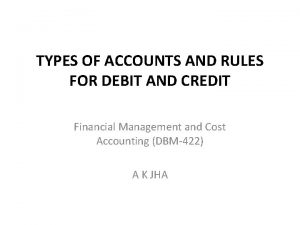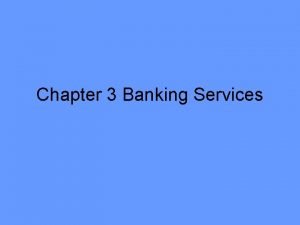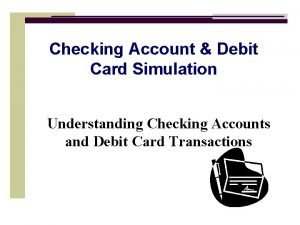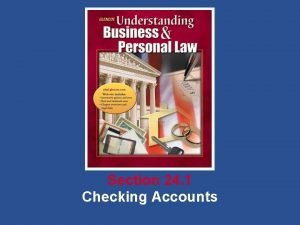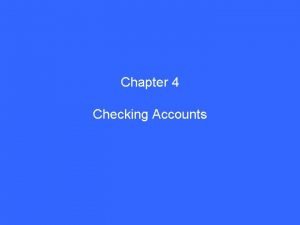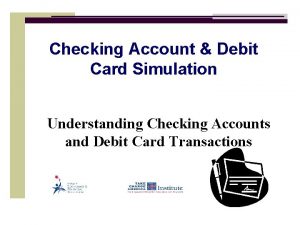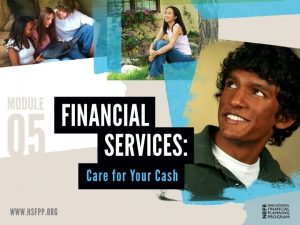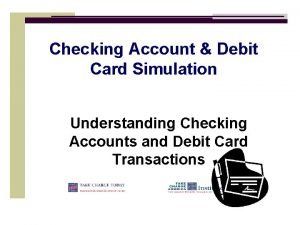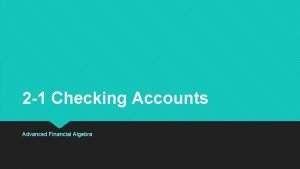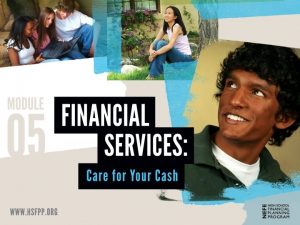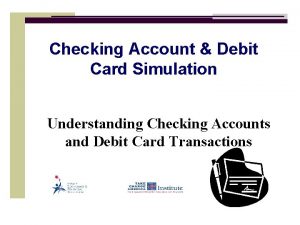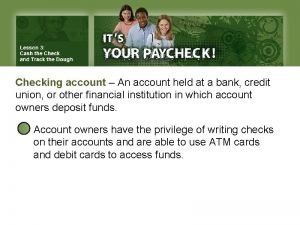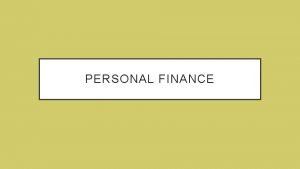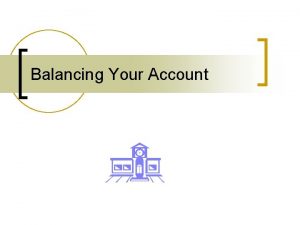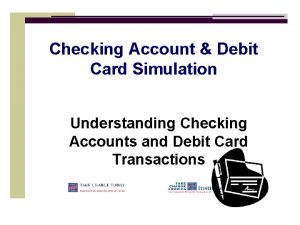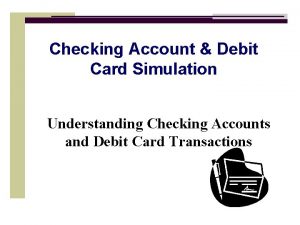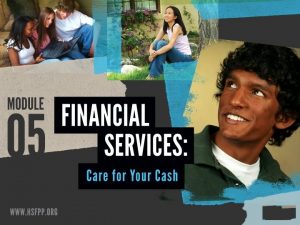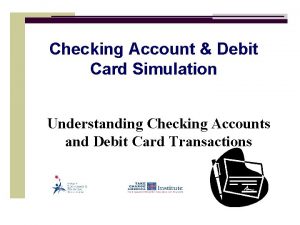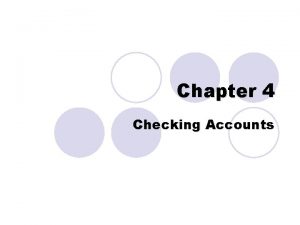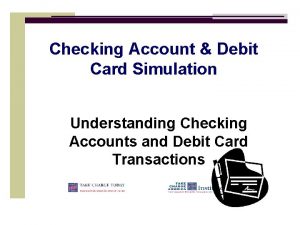Checking Accounts What is a Checking Account 1
















- Slides: 16

Checking Accounts

What is a Checking Account? 1. A checking account is a sum of money that you deposit in a bank or other financial institution, to hold for you and from which you write checks. 2. A check is a written order to a bank (DRAWER) to pay the specific amount of money to a particular person.

Advantages of Checks: Convenient 1. Can be used to send money through the mail, i. e. to pay bills. 2. Checks are safer than cash. 3. A cancelled check is a legal record of payment. 4. It is a record of how you spent your money.

Checking Account Terms 1. Cancelled Check – Check that is stamped and perforated to show it has been paid. 2. Insufficient Funds - Not enough money in account to pay check; the bank’s polite way of saying a check has bounced. (fee) 3. Stop Payment – An order by depositor to the bank to prevent payment of a check. (fee) 4. Float – Period of time it takes a check to be processed.

5. Certified Check – A check issued by the bank that insures the check amount will be paid because it has been set aside. (fee) 6. Cashiers Check – A check written on financial institution’s own account and signed by one of its officers. 7. Endorsing – Signing the back of a check. 8. Reconciling – Process of bringing your check record and bank statement into agreement.

Check Writing You need to write the following items on the face of the check: a. Payee – Name of person/business who receives the money after the words “PAY TO THE ORDER OF” b. Date c. Check number d. Amount – Written twice – numbers and words e. Signature of the person writing the check (DRAWEE) f. Memo – For recording the purpose of check

Check Endorsements 1. Blank – Your signature on back of check; 2. payable to anyone. 2. Restrictive – “For deposit only” and your signature on the back of the check; limits use of check. 3. Special or full – “Pay to the order of ____” and your signature on the back; limits payments to a particular payee.

Types of Checking Accounts 1. Special Checking Account 2. a. No minimum amount needed to open 3. b. Monthly fees* 4. c. Transactions fees*

2. Regular Checking Account 3. 4. a. Maintained minimum balance required (usually $500) 5. b. No transaction fees* 6. c. May be a penalty if your account falls below 7. minimum balance

3. NOW Account 4. a. Means Negotiable Order of Withdrawal 5. b. Interest bearing account 6. c. Requires minimum balance (usually $1000) 7. 8. * For all accounts: Banks may charge for other services, such as printing checks.

Other Payment Types Money Order – A check for a specified sum of money issued by a financial institution, a post office, an express or telegraph company, or a grocery store.

Telegraphic Money Order – A transfer of money through Western Union; useful in emergency, but very expensive. Traveler’s Checks – Checks which come in set denominations of $10, $20, $50, and $100 and are insured in case of loss; checks signed twice; service charge of 1%.

Banking Electronically Electronic Fund Transfer or (EFT) is the moving of money from one account to another by computer.

1. Automated Teller Machine – (ATM) computer 2. stations that can be used for certain banking 3. purposes. 2. Automated Bill Payment – Prearranged 3. electronic payments of certain bills.

3. Debit and Check Card – Used to make 4. purchases without writing a check and 5. amounts are automatically deducted from 6. your checking account. 4. Banking from Home – Making bill payments 5. through the use of a home computer.

Review: 1. Balance a checkbook register when you write 2. each check. 2. A bank’s record of your checking account which you receive monthly is called a statement. Balance a checking account statement when you receive the statement.
 Personal account real account nominal account
Personal account real account nominal account Chapter 9 checking accounts and banking services
Chapter 9 checking accounts and banking services Promissory note
Promissory note 3-1 savings accounts worksheet answers
3-1 savings accounts worksheet answers 2-1 checking accounts answers
2-1 checking accounts answers Chapter 4 checking accounts
Chapter 4 checking accounts Checking account simulation
Checking account simulation Checking account simulation
Checking account simulation Lesson 5-1 checking accounts answer key
Lesson 5-1 checking accounts answer key 3 1 checking accounts worksheet answers
3 1 checking accounts worksheet answers Financial algebra workbook 2-1 checking accounts answers
Financial algebra workbook 2-1 checking accounts answers Balance zoe's bucks
Balance zoe's bucks 3 1 checking accounts worksheet answers
3 1 checking accounts worksheet answers Checking account simulation
Checking account simulation Checking account and debit card simulation answers
Checking account and debit card simulation answers Jana has $100 to open a checking account
Jana has $100 to open a checking account Balancing your checking account worksheet answers
Balancing your checking account worksheet answers
